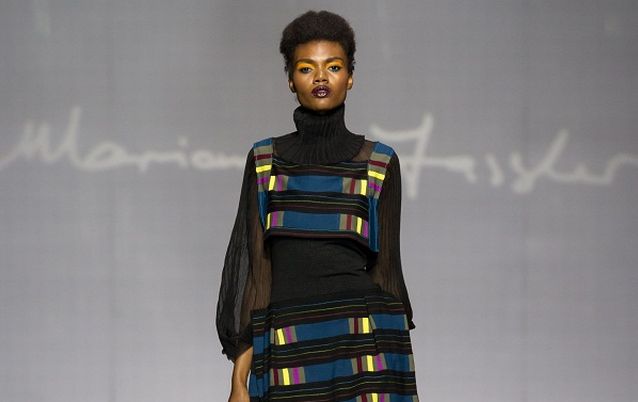Fassler teaches new kids what is trendy
by Mary Corrigall,
2016-03-18 05:00:00.0
IF YOU wanted to find out what is happening at both ends of the fashion spectrum, then there were two shows at the recent Mercedes-Benz Fashion Week Joburg that you had to catch: Marianne Fassler and the AFI Fast Track.
As one of the most established names in the fashion business, Fassler gives viewers a sense of what is happening at the top end, catering for the made-to-measure social butterflies, who buy into her distinctive signature and whatever cachet it evokes. Every collection tends to be a refining or redefinition of these qualities.
The Fast Track lets you in on what the kids graduating from fashion college are up to. This lot haven’t quite found their signature yet, are willing to take risks, but are also emulating and absorbing everything around them. The collections can go horribly south, or put someone on the map. The garments rarely hang that well on the models’ bodies, the fabrics are cheap, and sometimes designs are so out of sync with the design world that the front row cringes visibly.
There is an infectious energy on this platform, even if only when the young creator bounds down the ramp at the conclusion, exuding the buoyancy of someone on the edge of being discovered. In truth, these young designers probably have a better chance of success if they work under an established name and learn the tricks of the trade before creating their own labels. Nevertheless, these three-day fashion circuses need fresh fodder for ramp action.
Then there are those moments when a few garments at the Fassler show evince the frisson of youth you expect from the Fast Track. Such was the case with her winter collection, which presented some edgy, gothic-cum-African designs that showed a curious, playful designer keen to experiment.
Towards the end of the show, some tried-and-trusted leopard print garments with lace and mesh overlays took the audience back a few decades, but the opening numbers spoke of fresh innovation.
...
CHECKS are a winter staple and Fassler plays with this, creating check prints from felt appliques that appear like graphic African designs. In some garments, check fabrics are worked to look like futuristic prints that echo African block designs. This African futuristic twist was expanded on in a more unexpected way on black numbers with leather triangle cutouts adorning necklines, echoing beaded jewellery or fabric designs.
Fassler’s signature has long relied on the juxtaposition of clashing prints, articulating the mish-mash multiculturalism of our country. There were one or two ensembles embracing this, but what stood out was the strong interplay of textures: knife-pleated fabrics, matt leather contrasted with shiny materials, or velvet.
The collection opened with some dark and brooding gothic looks, but evolved into a patchwork of colour; with lilac, orange, and midnight blue taking centre stage. What a relief to be freed from Fassler’s fixation with African prints. The collection felt modern, edgy and now.
A lot more now than some of the retro designs on the Fast Track that felt like poor imitations of trends already in the shops. Sibusiso "Buda" Malete might only be 24, but his collection of men’s wear looked polished and had an edge to it.
...
MEN’S wear has become the new women’s wear in the sense that experimentation and the pushing of boundaries is occurring in this area of fashion. Malete played with asymmetry and volume in reinventing staple sportwear garments that hip hop culture has popularised. They were all rendered in black fabrics and looked easy to wear and sexy — men want to look sexy these days, and why shouldn’t this become a reality?
Fortunately, Malete was chosen along with four other designers from the platform to be mentored and given support. Neo Ranganka was not on that list, which was surprising. Of all the young designers, she showed the most design ingenuity with her streetwear collection defined by prints that appeared like 1980s-style graffiti.
Her work also exhibited strong by hip-hop culture influences.
The AFI Fast Track has delivered more design promise in the past.
The setting of this year’s fashion week, Nelson Mandela Square in the heart of Joburg’s largest shopping mecca, served as a bitter reminder to the designers that they have to compete with more and more international retailers that can deliver high-quality, affordable clothing. Some labels, such as Selfi, trade on local street cred and original prints, rather than design ingenuity or quality, but this cannot last.
The fashion show should be an opportunity for these designers to make an impression that only a live performance can do — it is the only advantage they have over the international retailers.
Fassler and David Tlale, who used half-naked men in undies to turn heads this year, have some idea how to achieve this. However, some of the younger designers have yet to understand the stage on which they perform and how to exploit fashion drama.
What a relief to be freed from Fassler’s fixation with African prints. The collection felt modern, edgy, and now
-

The Mercedes-Benz Fashion Week Joburg is a showcase for established and up-and-coming South African designers, with collections from established names such as Marianne Fassler and recent graduates at the AFI Fast Track show. Picture: SUPPLIED
-

The Mercedes-Benz Fashion Week Joburg is a showcase for established and up-and-coming South African designers, with collections from established names such as Marianne Fassler and recent graduates at the AFI Fast Track show. Picture: SUPPLIED
-

The Mercedes-Benz Fashion Week Joburg is a showcase for established and up-and-coming South African designers, with collections from established names such as Marianne Fassler and recent graduates at the AFI Fast Track show. Picture: SUPPLIED
-

The Mercedes-Benz Fashion Week Joburg is a showcase for established and up-and-coming South African designers, with collections from established names such as Marianne Fassler and recent graduates at the AFI Fast Track show. Picture: SUPPLIED
IF YOU wanted to find out what is happening at both ends of the fashion spectrum, then there were two shows at the recent Mercedes-Benz Fashion Week Joburg that you had to catch: Marianne Fassler and the AFI Fast Track.
As one of the most established names in the fashion business, Fassler gives viewers a sense of what is happening at the top end, catering for the made-to-measure social butterflies, who buy into her distinctive signature and whatever cachet it evokes. Every collection tends to be a refining or redefinition of these qualities.
The Fast Track lets you in on what the kids graduating from fashion college are up to. This lot haven’t quite found their signature yet, are willing to take risks, but are also emulating and absorbing everything around them. The collections can go horribly south, or put someone on the map. The garments rarely hang that well on the models’ bodies, the fabrics are cheap, and sometimes designs are so out of sync with the design world that the front row cringes visibly.
There is an infectious energy on this platform, even if only when the young creator bounds down the ramp at the conclusion, exuding the buoyancy of someone on the edge of being discovered. In truth, these young designers probably have a better chance of success if they work under an established name and learn the tricks of the trade before creating their own labels. Nevertheless, these three-day fashion circuses need fresh fodder for ramp action.
Then there are those moments when a few garments at the Fassler show evince the frisson of youth you expect from the Fast Track. Such was the case with her winter collection, which presented some edgy, gothic-cum-African designs that showed a curious, playful designer keen to experiment.
Towards the end of the show, some tried-and-trusted leopard print garments with lace and mesh overlays took the audience back a few decades, but the opening numbers spoke of fresh innovation.
...
CHECKS are a winter staple and Fassler plays with this, creating check prints from felt appliques that appear like graphic African designs. In some garments, check fabrics are worked to look like futuristic prints that echo African block designs. This African futuristic twist was expanded on in a more unexpected way on black numbers with leather triangle cutouts adorning necklines, echoing beaded jewellery or fabric designs.
Fassler’s signature has long relied on the juxtaposition of clashing prints, articulating the mish-mash multiculturalism of our country. There were one or two ensembles embracing this, but what stood out was the strong interplay of textures: knife-pleated fabrics, matt leather contrasted with shiny materials, or velvet.
The collection opened with some dark and brooding gothic looks, but evolved into a patchwork of colour; with lilac, orange, and midnight blue taking centre stage. What a relief to be freed from Fassler’s fixation with African prints. The collection felt modern, edgy and now.
A lot more now than some of the retro designs on the Fast Track that felt like poor imitations of trends already in the shops. Sibusiso "Buda" Malete might only be 24, but his collection of men’s wear looked polished and had an edge to it.
...
MEN’S wear has become the new women’s wear in the sense that experimentation and the pushing of boundaries is occurring in this area of fashion. Malete played with asymmetry and volume in reinventing staple sportwear garments that hip hop culture has popularised. They were all rendered in black fabrics and looked easy to wear and sexy — men want to look sexy these days, and why shouldn’t this become a reality?
Fortunately, Malete was chosen along with four other designers from the platform to be mentored and given support. Neo Ranganka was not on that list, which was surprising. Of all the young designers, she showed the most design ingenuity with her streetwear collection defined by prints that appeared like 1980s-style graffiti.
Her work also exhibited strong by hip-hop culture influences.
The AFI Fast Track has delivered more design promise in the past.
The setting of this year’s fashion week, Nelson Mandela Square in the heart of Joburg’s largest shopping mecca, served as a bitter reminder to the designers that they have to compete with more and more international retailers that can deliver high-quality, affordable clothing. Some labels, such as Selfi, trade on local street cred and original prints, rather than design ingenuity or quality, but this cannot last.
The fashion show should be an opportunity for these designers to make an impression that only a live performance can do — it is the only advantage they have over the international retailers.
Fassler and David Tlale, who used half-naked men in undies to turn heads this year, have some idea how to achieve this. However, some of the younger designers have yet to understand the stage on which they perform and how to exploit fashion drama.
What a relief to be freed from Fassler’s fixation with African prints. The collection felt modern, edgy, and now



























Change: 1.19%
Change: 1.36%
Change: 2.19%
Change: 1.49%
Change: -0.77%
Data supplied by Profile Data
Change: -0.19%
Change: 0.69%
Change: 1.19%
Change: 0.00%
Change: 0.44%
Data supplied by Profile Data
Change: 0.62%
Change: 0.61%
Change: 0.23%
Change: 0.52%
Change: 0.12%
Data supplied by Profile Data
Change: -0.21%
Change: -1.22%
Change: -0.69%
Change: -0.51%
Change: 0.07%
Data supplied by Profile Data